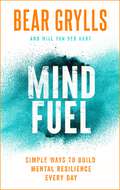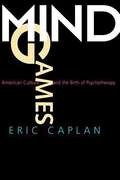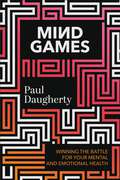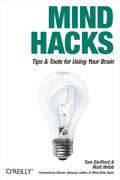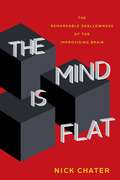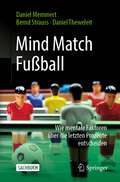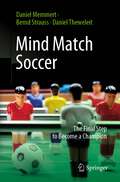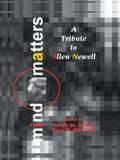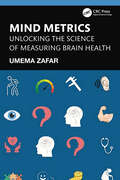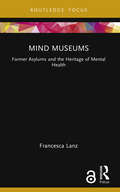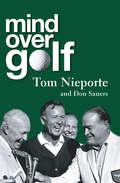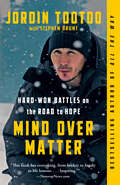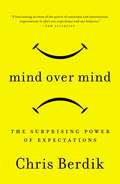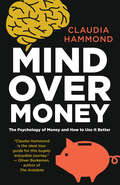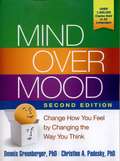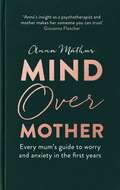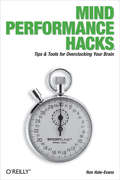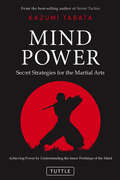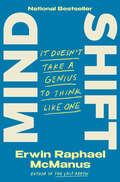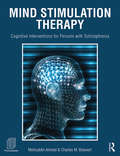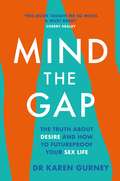- Table View
- List View
Mind Fuel: Simple Ways to Build Mental Resilience Every Day
by Bear GryllsThe world's most recognised adventurer Bear Grylls offers daily tips to help you build mental resilience.Bear Grylls draws on his survival experience to share the principles that have helped him overcome fear, develop a positive mindset and break through the obstacles that limit success in everyday life. With emotional health advocate Will Van Der Hart, MIND FUEL offers you practical insights to help you to increase your resilience, combat stress and live life with confidence. Topics are categorised into eight broader themes at enable you to access the material you need most - covering wisdom, battles, motivation, courage, relationships, self-care, spirituality and determination. From the bestselling author of Mud, Sweat and Tears, MIND FUEL gives you a whole year's worth of guidance to face whatever life throws at you.
Mind Games: American Culture and the Birth of Psychotherapy
by Eric CaplanEric Caplan's fascinating exploration of Victorian culture in the United States shatters the myth of Freud's seminal role in the creation of American psychotherapy. Resurrecting the long-buried "prehistory" of American mental therapeutics, Mind Games tells the remarkable story of how a widely assorted group of actors--none of them hailing from Vienna or from any other European city--compelled a reluctant medical profession to accept a new role for the mind in medicine. By the time Freud first set foot on American soil in 1909, as Caplan demonstrates, psychotherapy was already integrally woven into the fabric of American culture and medicine. Mind Games shows how psychotherapy came to occupy its central position in mainstream American culture.
Mind Games: Winning the Battle for Your Mental and Emotional Health
by Paul DaughertyIn this important book, a megachurch pastor acknowledges the mental health crisis happening in our churches today and gives readers practical tools to fight back against depression, anxiety, and insecurity—and help them find victory. Depression, anxiety, and emotional trauma are on the rise, even more so after the painful few years we&’ve all been through. While the church has had an unfortunate track record of glossing over mental health issues, Paul Daugherty, pastor of the megachurch Victory, believes it&’s time for the church to break its silence. You can&’t just pray trauma away. Depression and anxiety can affect even the most devoted believer. In this book, Paul Daugherty walks readers through some of the biggest mental and emotional health issues he has seen people in his life and his congregation facing, including depression, anxiety, insecurity, mood swings, and the scars of trauma. Daugherty dives into scripture and lays a framework for understanding the spiritual truths behind each mental battle. He also offers practical tips and strategies to help readers find lasting victory. The result is an invaluable handbook that will help Christians and non-believers alike.
Mind Hacks: Tips & Tricks for Using Your Brain
by Tom Stafford Matt WebbThe brain is a fearsomely complex information-processing environment--one that often eludes our ability to understand it. At any given time, the brain is collecting, filtering, and analyzing information and, in response, performing countless intricate processes, some of which are automatic, some voluntary, some conscious, and some unconscious.Cognitive neuroscience is one of the ways we have to understand the workings of our minds. It's the study of the brain biology behind our mental functions: a collection of methods--like brain scanning and computational modeling--combined with a way of looking at psychological phenomena and discovering where, why, and how the brain makes them happen.Want to know more? Mind Hacks is a collection of probes into the moment-by-moment works of the brain. Using cognitive neuroscience, these experiments, tricks, and tips related to vision, motor skills, attention, cognition, subliminal perception, and more throw light on how the human brain works. Each hack examines specific operations of the brain. By seeing how the brain responds, we pick up clues about the architecture and design of the brain, learning a little bit more about how the brain is put together.Mind Hacks begins your exploration of the mind with a look inside the brain itself, using hacks such as "Transcranial Magnetic Stimulation: Turn On and Off Bits of the Brain" and "Tour the Cortex and the Four Lobes." Also among the 100 hacks in this book, you'll find:Release Eye Fixations for Faster ReactionsSee Movement When All is StillFeel the Presence and Loss of AttentionDetect Sounds on the Margins of CertaintyMold Your Body SchemaTest Your HandednessSee a Person in Moving LightsMake Events Understandable as Cause-and-EffectBoost Memory by Using ContextUnderstand Detail and the Limits of AttentionSteven Johnson, author of "Mind Wide Open" writes in his foreword to the book, "These hacks amaze because they reveal the brain's hidden logic; they shed light on the cheats and shortcuts and latent assumptions our brains make about the world." If you want to know more about what's going on in your head, then Mind Hacks is the key--let yourself play with the interface between you and the world.
Mind Is Flat: The Remarkable Shallowness of the Improvising Brain
by Nick ChaterIn a radical reinterpretation of how the mind works, an eminent behavioral scientist reveals the illusion of mental depth Psychologists and neuroscientists struggle with how best to interpret human motivation and decision making. The assumption is that below a mental “surface” of conscious awareness lies a deep and complex set of inner beliefs, values, and desires that govern our thoughts, ideas, and actions, and that to know this depth is to know ourselves. In this profoundly original book, behavioral scientist Nick Chater contends just the opposite: rather than being the plaything of unconscious currents, the brain generates behaviors in the moment based entirely on our past experiences. Engaging the reader with eye-opening experiments and visual examples, the author first demolishes our intuitive sense of how our mind works, then argues for a positive interpretation of the brain as a ceaseless and creative improviser.
Mind Match Fußball: Wie mentale Faktoren über die letzten Prozente entscheiden
by Daniel Memmert Bernd Strauss Daniel TheweleitEnge Fußballspiele und knappe Titelkämpfe werden nur selten durch technische Fähigkeiten von Spielern oder taktische Maßnahmen ihrer Trainer entschieden. Die bedeutsamsten Impulse kommen aus einem Bereich, der oft erwähnt wird, aber nur schwer greifbar ist: Große Champions sprechen nach besonderen Siegen eher über mentale Stärken, Persönlichkeitsmerkmale und den Zusammenhalt in ihren Teams. Dieses Buch beschreibt anhand aktueller wissenschaftlicher Kenntnisse und durch viele Beispiele illustriert die mentalen und kognitiven Prozesse, die über Sieg und Niederlage im Fußball entscheiden. Interviews mit Trainern wie Ralf Rangnick, Ottmar Hitzfeld und Christian Streich, Sportmanagern wie Fredi Bobic und ehemaligen Spielern wie Matthias Sammer ergänzen diese Erkenntnisse aus der Wissenschaft in Interviews über wegweisende Momente und prägende Erfahrungen in ihren Karrieren. Es geht um Phänomene wie den Heimvorteil, Kreativität, emotionale Extremsituationen, die Grenzen der Wahrnehmung, gruppendynamische Prozesse, moderne Führung und Mythen des Spiels, die sich oft widerlegen lassen. Für jeden Fußballinteressierten wird so schnell ersichtlich, welche Phänomene tatsächlich spielentscheidend sein können und welche nicht.
Mind Match Soccer: The Final Step to Become a Champion
by Daniel Memmert Bernd Strauss Daniel TheweleitClose soccer matches and tight title fights are rarely decided by players' technical skills or their coaches' tactical measures. The most significant impetus comes from an area that is often mentioned but difficult to grasp: mental strength, personality, and team cohesion after special victories. Using current scientific knowledge and illustrated by many examples, this book describes the mental and cognitive processes that determine victory and defeat in soccer. Several interviews with well-known soccer coaches, managers and former players complement these findings from psychology and sport science.It deals with phenomena such as the home field advantage, creativity on the field, extreme emotional situations, the limits of visual perception, group dynamics and modern leadership. Well-known myths (e.g. Don't let the player who has been fouled shoot the penalty) will be discussed and debunked. Every soccer enthusiast should read this book in order to understand which phenomena can genuinely be game-changing and which ones cannot.
Mind Matters: A Tribute To Allen Newell (Carnegie Mellon Symposia on Cognition Series)
by David Steier Tom M. MitchellBased on a symposium honoring the extensive work of Allen Newell -- one of the founders of artificial intelligence, cognitive science, human-computer interaction, and the systematic study of computational architectures -- this volume demonstrates how unifying themes may be found in the diversity that characterizes current research on computers and cognition. The subject matter includes: * an overview of cognitive and computer science by leading researchers in the field; * a comprehensive description of Allen Newell's "Soar" -- a computational architecture he developed as a unified theory of cognition; * commentary on how the Soar theory of cognition relates to important issues in cognitive and computer science; * rigorous treatments of controversial issues in cognition -- methodology of cognitive science, hybrid approaches to machine learning, word-sense disambiguation in understanding material language, and the role of capability processing constraints in architectural theory; * comprehensive and systematic methods for studying architectural evolution in both hardware and software; * a thorough discussion of the use of analytic models in human computer interaction; * extensive reviews of important experiments in the study of scientific discovery and deduction; and * an updated analysis of the role of symbols in information processing by Herbert Simon. Incorporating the research of top scientists inspired by Newell's work, this volume will be of strong interest to a large variety of scientific communities including psychologists, computational linguists, computer scientists and engineers, and interface designers. It will also be valuable to those who study the scientific process itself, as it chronicles the impact of Newell's approach to research, simultaneously delving into each scientific discipline and producing results that transcend the boundaries of those disciplines.
Mind Metrics: Unlocking the Science of Measuring Brain Health
by Umema ZafarBrain health, as opposed to mental health, is a neglected phenomenon, less discovered but now capturing more attention. Currently, the concepts surrounding brain health are vague and no clear definition of this term exists. Assessing brain health early in life may offer insights into impending disruptions in brain function. If deteriorating or poor health of the brain is detected at a young age, therapeutic steps can be taken. The definition of brain health is "the preservation of optimal brain integrity and mental and cognitive function at a given age in the absence of overt brain diseases that affect normal brain function." Recently, cognitive age has been used as a better indicator of brain health called the "cognitive clock." This book reviews, for example, fMRI, EEG, and PET scans as well as measuring certain blood and CSF biomarker levels. A new noninvasive, cost-effective, and easily implemented tool for gauging brain health is introduced. This tool can be used in rural communities as well as in low- and middle-income countries (LMIC). This book focuses on the development of this new tool for brain health measurement as well as its cross-validation in diseased and healthy populations.
Mind Museums: Former Asylums and the Heritage of Mental Health (Museums in Focus)
by Francesca LanzMind Museums offer a fresh perspective on the heritage of mental health,bringing museums into sharp focus. Drawing on interdisciplinary approachesfrom architecture, museum and exhibition design, and heritage and museumstudies, it examines former psychiatric asylums that have been converted intomuseums.The book presents a comprehensive investigation of mind museums, thefirst of its kind in Europe, and explores their potential in raising awarenessand dismantling the stigma surrounding mental health. Through an indepthexamination of selected European examples, Lanz describes whatmind museums are and how they came to be. The innovative visitor studiescarried out at the Museo di Storia della Psichiatria in Reggio Emilia, whichare presented here, explore people’s encounters with mind museums andreveal the profound impact of such experiences. By uncovering the power ofthese heritage sites in facilitating discussions on mental health, civility, andcare, Lanz provides new insights into the emotive capacity of the museumand visitors’ reflexivity at place-based memory sites.Mind Museums will be of great interest to scholars and postgraduatelevelstudents engaged in the study of museums, heritage, exhibitiondesign, architecture, and mental health. It should also be of interest toheritage professionals, particularly those working in mind museums andother similar sites, such as prison museums and sites of conscience.
Mind Over Golf: A Beginner's Guide to the Mental Game
by Don Sauers Tom NieporteThere&’s an interesting point at which the psychological and technical sides of golf meet--and Tom Nieporte and Don Sauers discover this by talking with America&’s leading golf professionals. The tips provided in this book will help golfers of any level discover or regain confidence that will drop strokes off of every golfer&’s score. Any golfer must know how to master the eight major golfing skills, and from this book golfers will learn how easy it is to turn handicapping weaknesses into winning strengths. The most valuable advice here is sure to cultivate winners on the green!
Mind Over Matter: Hard-Won Battles on the Road to Hope
by Stephen Brunt Jordin TootooFollowing the bestselling success of the inspiring All the Way, pioneering Inuit NHLer Jordin Tootoo begins the process of healing in the wake of the suicide and violence that marks his family, only to discover the source of all that trauma in his father's secret past.For some hockey players, retirement marks the moment when it&’s all over. But Jordin Tootoo is not most hockey players.Having inspired millions when he first broke into the league, Tootoo continued to influence people throughout his career—not only through his very public triumph over alcoholism, but also his natural charisma. And now, years after hanging up his skates, he is more committed to doing things the right way and speaking about it to others, whether it&’s corporate executives or Indigenous youth.But the news of unmarked graves on the grounds of residential schools brought back to life many of the demons that had haunted his family. In a moment of realization that left him rattled and saddened, Tootoo fit the pieces together. The years that were never spoken of. The heavy drinking. The all too predictable violence. His father was a survivor, marked by what he had survived.As he travels back to Nunavut to try to speak with his father about what haunts him, he encounters the ghosts of the entire community. Still, as Tootoo says, we are continuously learning and rewriting our story at every step. He has learned from his mistakes and his victories. He has learned from examples of great courage and humility. He has learned from being a father and a husband. And he has learned from his own Inuk traditions, of perseverance and discipline in the face of hardship.Weaving together life&’s biggest themes with observations and experiences, Jordin shares the kind of wisdom he has had to specialize in—the hard-won kind.
Mind Over Mind: The Surprising Power of Expectations
by Chris BerdikHow our fast-forward minds make something out of nothing.<P> We all know expectations matter--in school, in sports, in the stock market. From a healing placebo to a run on the bank, hints of their self-fulfilling potential have been observed for years. But we've never fully understood why.<P> Journalist Chris Berdik offers a captivating look at the frontiers of expectations research, revealing how our assumptions bend reality.<P> We learn how placebo calories can fill us up, how fake surgery can sometimes work better than real surgery, and how imaginary power can be corrupting. Mind Over Mind is a journey into the most exciting area of brain research today.<P> We meet scientists who have found that wearing taller and more attractive avatars in a virtual world boosts confidence in real life, gambling addicts whose brains make losing feel like winning, and coaches who put blurry glasses on athletes to lift them out of slumps. <P> Along the way, Berdik probes the paradox of expectations. Their influence seems based on illusion, even trickery, but they can create their own reality, for good or for ill. Expectations can heal our bodies and make us stronger, smarter, and more successful, or they can leave us in agony, crush our spirit, and undermine our free will. If we can unlock their secrets, we may be able to harness their power and sidestep their pitfalls. <P> Drawing on psychology, neuroscience, history, and fascinating true stories of xpectations in action, Mind Over Mind offers a spirited journey into one of the most exciting areas of brain research today.
Mind Over Money: The Psychology of Cash and How to Use It Better
by Claudia HammondOn a summer evening in 1994, the two members of the band KLF burned £1 million in £50 notes in a barn on the Isle of Jura. They filmed themselves tossing the bills into the fire, and made the story public. The reaction amazed them: this act of nihilism caused a public outpouring of rage. They received death threats. And yet, if the band members had squandered their wealth away on designer clothes and sports cars, would anyone have cared?We constantly make assumptions about money. We confuse it with morality. We know we need it, and we tend to want more of it, but what we do not always appreciate are the ways it affects our minds, and emotions, and can even skew our perceptions.Mind Over Money is about what money does to us. In delightfully accessible language, Hammond explores the power of money and shows how psychology and neuroscience are providing us with some extraordinary tools for making better decisions about the way we use money.
Mind Over Mood
by Christine A. Padesky Dennis GreenbergerExpanded content on anxiety, Chapters on setting personal goals and maintaining progress, Happiness rating scales,Gratitude journals, Innovative exercises focused on Mindfulness, Acceptance, and Forgiveness, 25 New Worksheets; and much more.
Mind Over Mother: Every mum's guide to worry and anxiety in the first years
by Anna MathurTHE SUNDAY TIMES BESTSELLER'With conversations on Maternal Mental Health on the rise, and more women speaking up about the way they feel, Anna Mathur's insight as a psychotherapist AND mother make her someone you feel you can trust. She offers little nuggets of gold while reminding us to point some of our kindness and love inwards.' Giovanna Fletcher, bestselling author of Happy Mum, Happy Baby 'Anna is breath of fresh air - relatable, funny and wise' Sarah Turner, bestselling author of The Unmumsy MumBaby-proof the house; panic-proof the mum.Do you overthink what you said to the mum in the supermarket queue? Is your internal dialogue more critical than kind? Perhaps you wake to check your baby is breathing, or the sight of a rash sends you down an internet search rabbit hole. Whatever your level of anxiety, however much it impacts your life, this book is for you.Anxiety is making motherhood a less pleasant, more fraught and pressured experience, and we do not have to accept joy-sapping worry and energy-draining overthinking as part of the motherhood job description. In Mind Over Mother, Anna Mathur, psychotherapist and mum of three, explains how to:* Understand anxiety, why it affects you and what to do about it* Make your mind a kinder, calmer, happier place to be* Transform your motherhood experience by addressing your thinkingThe most powerful tool Anna has to communicate this isn't the letters after her name, it is the fact that she is open about her own experience of maternal anxiety. By sharing her journey, she gives you the confidence to reframe yours. Mind Over Mother is full of light bulb moments of realisation. It will have you learning, laughing and loving yourself through the journey of motherhood. You will learn to address the most important conversation you'll ever have - the one inside your head, because investing in your mental health is the best gift you can offer yourself and your child.
Mind Over Mother: Every mum's guide to worry and anxiety in the first years
by Anna MathurTHE SUNDAY TIMES BESTSELLER'With conversations on Maternal Mental Health on the rise, and more women speaking up about the way they feel, Anna Mathur's insight as a psychotherapist AND mother make her someone you feel you can trust. She offers little nuggets of gold while reminding us to point some of our kindness and love inwards.' Giovanna Fletcher, bestselling author of Happy Mum, Happy Baby 'Anna is breath of fresh air - relatable, funny and wise' Sarah Turner, bestselling author of The Unmumsy MumBaby-proof the house; panic-proof the mum.Do you overthink what you said to the mum in the supermarket queue? Is your internal dialogue more critical than kind? Perhaps you wake to check your baby is breathing, or the sight of a rash sends you down an internet search rabbit hole. Whatever your level of anxiety, however much it impacts your life, this book is for you.Anxiety is making motherhood a less pleasant, more fraught and pressured experience, and we do not have to accept joy-sapping worry and energy-draining overthinking as part of the motherhood job description. In Mind Over Mother, Anna Mathur, psychotherapist and mum of three, explains how to:* Understand anxiety, why it affects you and what to do about it* Make your mind a kinder, calmer, happier place to be* Transform your motherhood experience by addressing your thinkingThe most powerful tool Anna has to communicate this isn't the letters after her name, it is the fact that she is open about her own experience of maternal anxiety. By sharing her journey, she gives you the confidence to reframe yours.Mind Over Mother is full of light bulb moments of realisation. It will have you learning, laughing and loving yourself through the journey of motherhood. You will learn to address the most important conversation you'll ever have - the one inside your head, because investing in your mental health is the best gift you can offer yourself and your child.
Mind Performance Hacks: Tips & Tools for Overclocking Your Brain
by Ron Hale-EvansYou're smart. This book can make you smarter.Mind Performance Hacks provides real-life tips and tools for overclocking your brain and becoming a better thinker. In the increasingly frenetic pace of today's information economy, managing your life requires hacking your brain. With this book, you'll cut through the clutter and tune up your brain intentionally, safely, and productively.Grounded in current research and theory, but offering practical solutions you can apply immediately, Mind Performance Hacks is filled with life hacks that teach you to:Use mnemonic tricks to remember numbers, names, dates, and other flotsam you need to recallPut down your calculator and perform complex math in your head, with your fingers, or on the back of a napkinSpark your creativity with innovative brainstorming methodsUse effective systems to capture new ideas before they get awayCommunicate in creative new ways-even using artificial languagesMake better decisions by foreseeing problems and finding surprising solutionsImprove your mental fitness with cool tricks and gamesWhile the hugely successful Mind Hacks showed you how your brain works, Mind Performance Hacks shows you how to make it work better.
Mind Power
by Kazumi Tabata Kaiichi HasumiAt the earliest stages of learning a martial art, students almost exclusively study the physical techniques. It is only after much time and intensive practice that these techniques become automatic. Reaching the point of ingrained movements is a major step in mastering a martial art. Yet when the practitioner learns to become one with himself, the opponent and with nature itself, when the opponent's moves appear as if in slow motion, the practitioner moves without thought and becomes unbeatable.In Mind Power, Master Kazumi Tabata, Grand Master in the Shotokan and Shorinji styles of Karate, offers his personal teachings as to how martial arts students can reach the point where time seems to slow down, quick movements are seen in slow motion, and the full potential of one's inner power can be harnessed.
Mind Power
by Kazumi Tabata Kaiichi HasumiAt the earliest stages of learning a martial art, students almost exclusively study the physical techniques. It is only after much time and intensive practice that these techniques become automatic. Reaching the point of ingrained movements is a major step in mastering a martial art. Yet when the practitioner learns to become one with himself, the opponent and with nature itself, when the opponent's moves appear as if in slow motion, the practitioner moves without thought and becomes unbeatable.In Mind Power, Master Kazumi Tabata, Grand Master in the Shotokan and Shorinji styles of Karate, offers his personal teachings as to how martial arts students can reach the point where time seems to slow down, quick movements are seen in slow motion, and the full potential of one's inner power can be harnessed.
Mind Power
by Kazumi Tabata Kaiichi HasumiLife is full of adversities. There comes a time when education, social status, fame, fortune, and even family ties all become useless. At a decisive moment like this, the ability to focus one's entire being--to harness one's total spiritual and mental energy--is required for survival and success. In this book, Master Kazumi Tabata shares his knowledge in how to achieve this goal.When beginning any martial arts discipline, students study physical techniques. Only after much time and intense practice do these techniques become second nature. Yet there is a higher level where you feel at one with yourself, your opponent, and with the world around you . Your opponent moves in slow motion, whereas you move without thought, and you become unbeatable.In Mind Power: Secret Strategies for the Martial Arts, Kazumi Tabata, Grandmaster in the Shotokan and Shorinji styles of Karate, offers his personal teachings as to how martial arts students can reach the point where time seems to slow down, quick movements are seen in slow motion, and the full potential of one's inner power can be harnessed.Chapters Include:StrategyBasic Laws of the Body and MindStrategy of a Virtuous ManHow to Interpert Your Mind
Mind Power: The Sixth Sense
by Ethirajan RathakrishnanThis book explores the mysteries of the human brain and the potential of the mind. The peculiarities and infinitude of the mind have been a theme for research for scientists and philosophers alike, for centuries. This volume presents the unanswered and highly convoluted questions and hypotheses surrounding the human mind in a simplified way. It examines the binaries of religion and science, god and nature and emotions and intelligence through a philosophical lens to posit that the relationships between cognition, belief, nature and science are what we understand and infer based on our surroundings and how much we are willing to think, learn and introspect.This book will be of interest to students of philosophy, psychology, science, popular science, psychoanalysis, cognitive studies and mental health. It will also appeal to general readers.
Mind Shift: It Doesn't Take a Genius to Think Like One
by Erwin Raphael McManusNATIONAL BESTSELLER • Mental toughness, mental clarity, and mental health all have one thing in common: The journey begins in your mind. In this radical guide, the award-winning author of The Last Arrow illuminates a surprising path toward personal fulfillment and optimal performance.&“Erwin McManus is the most brilliant thinker I&’ve ever met.&”—fourteen-time bestselling author Jon GordonThroughout his thirty years of work as a mindset expert and leadership coach, Erwin Raphael McManus has been obsessed with these questions: Why do some people succeed despite having all the odds stacked against them? How do others achieve the unthinkable, only to watch their lives slip away? Are there mental structures for failure and success?McManus has come to realize that too many of us have &“near-life&” experiences. We almost pursue our dreams. We almost make the decision that changes everything. We are always one choice away. If we want to live without regret, we need to make a mind shift—trading beliefs that limit our potential for ones that help us move toward optimal performance and pursue the success of being fully alive. We must move from a life of obligation to a life of intention.In Mind Shift, McManus brings together twelve mental frameworks that have helped some of the most accomplished people on earth create internal structures of success. Among them:• You have to choose between acceptance and uniqueness. If you are addicted to affirmation, you will become what others want you to be rather than who you were created to become.• You don&’t need an audience. It&’s what you do in private that makes you who you are.• Talent is a hallucinogen. It will make you believe that hard work and discipline are for everyone else.Sharing experiences from entrepreneurs, artists, professional athletes, and his own career, McManus shows us how to transform our thinking—and, in turn, transform our lives.
Mind Stimulation Therapy: Cognitive Interventions for Persons with Schizophrenia
by Mohiuddin Ahmed Charles M. BoisvertThis book presents a psychotherapy intervention model called Multimodal Integrative Cognitive Stimulation Therapy (MICST). It is grounded in information processing and cognitive stimulation techniques and operates out of a positive psychology framework. This model, designed for group work with clients with schizophrenia, can be easily tailored to working with clients in individual therapy sessions. The three core MICST group activities include: 1) body movement-mindfulness-relaxation (BMR); 2) cognitive stimulation using group discussions; and 3) cognitive stimulation using paper-pencil cognitive exercises and self-reflection exercises. A chapter is devoted to each of these core areas with actual case vignettes to illustrate ways that these activities can be implemented in clinical practice. Homework recommendations are included at the end of each chapter, devoted to a core MICST group activity and providing suggestions on ways to practice various skills and exercises in between group sessions. Also provided are several handouts and worksheets which can be used with clients.
Mind The Gap: The truth about desire and how to futureproof your sex life
by Dr Karen Gurney'This book taught me so much about female desire. A must read!' Cherry HealeyDid you know that there is an orgasm gap of around 30% between heterosexual couples when they have sex? In Mind The Gap, Dr Karen Gurney, a clinical psychologist and certified psychosexologist, explores not just this gap, but the gaps in our knowledge of so much of the most important new science around sex and desire. In this book, you will learn that nearly everything that you've been led to believe about female sexuality isn't actually true. And that, despite what you might think, it is possible to simultaneously feel little to no spontaneous desire and have a happy and mutually satisfying sex life long term.Exploring the mismatch between ideas about sex in our society and what the science tells us, Mind The Gap also explains how this disconnect lies at the root of many of our sexual problems. Combining science with case studies, practical exercises and tips, this is a book for anyone who wants to better understand the mechanics of desire and futureproof their sex life, for life.
